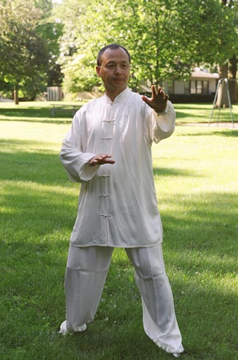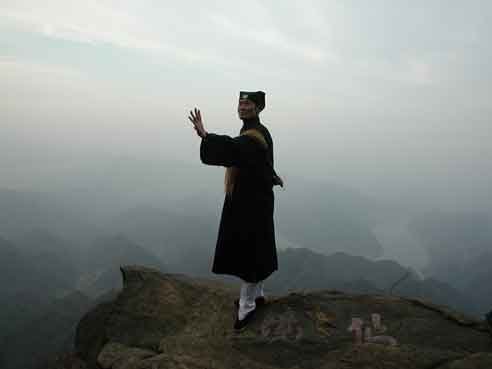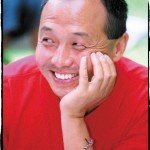Why Standing Meditation?
by Yang Yang, Ph.D.
Why do we do standing meditation (standing wuji)? This is one of the most frequently asked questions, and it comes both from beginners as well as long time Taiji form practitioners.
 It is strength training to your legs while you bend your knees and flex your hip joints slightly (i.e. sink into the “kua”). It is strength training to your arms while you hold your arms at different positions. (Note that during training, you should change the position of the arms. You should not attempt to push past your limit in holding your arms extended, nor should you quit at the first sign of discomfort. Rather, learn to relax into the posture. Lower or change your arm position when you fell necessary, and raise them again when you feel comfortable to do so). Very importantly, it is core strength training; the muscles of the core are constantly engaged to maintain correct posture during standing meditation. The core strength training is intensified when the arms are held extended in front of the body – the bodies’ response to counter the forward shift in the center of mass and maintain “central equilibrium” is to contract core musculature. Indeed, if the core musculature is not engaged you would fall forward when extending the arms. Building, and learning to use, core strength (i.e. internal), instead of muscle contraction from the limbs/extremities (i.e. “external”), is an integral mechanism of internal martial power, and standing meditation is where this is first learned.
It is strength training to your legs while you bend your knees and flex your hip joints slightly (i.e. sink into the “kua”). It is strength training to your arms while you hold your arms at different positions. (Note that during training, you should change the position of the arms. You should not attempt to push past your limit in holding your arms extended, nor should you quit at the first sign of discomfort. Rather, learn to relax into the posture. Lower or change your arm position when you fell necessary, and raise them again when you feel comfortable to do so). Very importantly, it is core strength training; the muscles of the core are constantly engaged to maintain correct posture during standing meditation. The core strength training is intensified when the arms are held extended in front of the body – the bodies’ response to counter the forward shift in the center of mass and maintain “central equilibrium” is to contract core musculature. Indeed, if the core musculature is not engaged you would fall forward when extending the arms. Building, and learning to use, core strength (i.e. internal), instead of muscle contraction from the limbs/extremities (i.e. “external”), is an integral mechanism of internal martial power, and standing meditation is where this is first learned.
It is posture training by elongating our body (imagining growing one inch taller).
It is balance training as you are constantly changing the profile of agonist and antagonist unconsciously while you breath in and out in quiet standing – it is even more demanding balance training if you close your eyes.
It is relaxation/efficiency training as you are constantly identifying and removing tension throughout your body: you are learning to use only the muscles needed to accomplish a certain motor task (in this case, standing). This partly assumes you have already been doing sitting and lying-down meditation and have made progress in cultivating static relaxation. If you cannot relax and maximize muscle efficiency in standing meditation, how can you relax and maximize muscle efficiency while doing Taiji movement?
 Standing is the beginning of Taiji: the beginning of carrying static relaxation over into a dynamic situation in a very gentle way. It is like push hands practice without touching a partner. For example, imaging that you are standing in water and moving randomly with water, you are essentially practicing efficient engagement with the water. It is like pushing hands with someone exerting energy but in the direction of your random moving. Because the movement is randomized, you are literally practicing push hands with John, David, Susan, and someone you never met before. The unlimited possibility of the randomization mimics unlimited push hand partners.
Standing is the beginning of Taiji: the beginning of carrying static relaxation over into a dynamic situation in a very gentle way. It is like push hands practice without touching a partner. For example, imaging that you are standing in water and moving randomly with water, you are essentially practicing efficient engagement with the water. It is like pushing hands with someone exerting energy but in the direction of your random moving. Because the movement is randomized, you are literally practicing push hands with John, David, Susan, and someone you never met before. The unlimited possibility of the randomization mimics unlimited push hand partners.
Last and most importantly, wuji is tranquility training. In practice, you might imagine you are retired and have nothing to do except standing on the beach to enjoy nature and cultivate your energy What better gift we can give ourselves?
These are some of the reasons why the oral and written tradition repeatedly emphasizes the importance of standing meditation for efficient Taiji training.*
*Note: complete discussion of the methods and purpose of standing meditation, with references to many famous traditional sayings and writings, is available in Dr. Yang Yang’s book Taijiquan: The Art of Nurturing, The Science of Power.
 [Yang Yang was born in 1960s in Henan province near the Chen Village in China. At the age of 12, he began studying Taiji because of a congenital heart defect. He credits his practice of Chen Style Taiji with curing his heart condition and allowing him to pass the physical exam required in China to enter the universities. Master Yang’s Taiji studies now span 30 years. With both Law and Engineering degrees earned in China, Master Yang practiced business law for several years before coming to the United States to study for a Master’s Degree in Economics at Illinois State University. He is currently the Director of the Center for Taiji Studies in Champaign, Illinois, and has recently completed a Doctorate Degree in Kinesiology at the University of Illinois. His research focuses on the benefits and mechanisms of Taiji practice.]
[Yang Yang was born in 1960s in Henan province near the Chen Village in China. At the age of 12, he began studying Taiji because of a congenital heart defect. He credits his practice of Chen Style Taiji with curing his heart condition and allowing him to pass the physical exam required in China to enter the universities. Master Yang’s Taiji studies now span 30 years. With both Law and Engineering degrees earned in China, Master Yang practiced business law for several years before coming to the United States to study for a Master’s Degree in Economics at Illinois State University. He is currently the Director of the Center for Taiji Studies in Champaign, Illinois, and has recently completed a Doctorate Degree in Kinesiology at the University of Illinois. His research focuses on the benefits and mechanisms of Taiji practice.]

One Response to From the Master